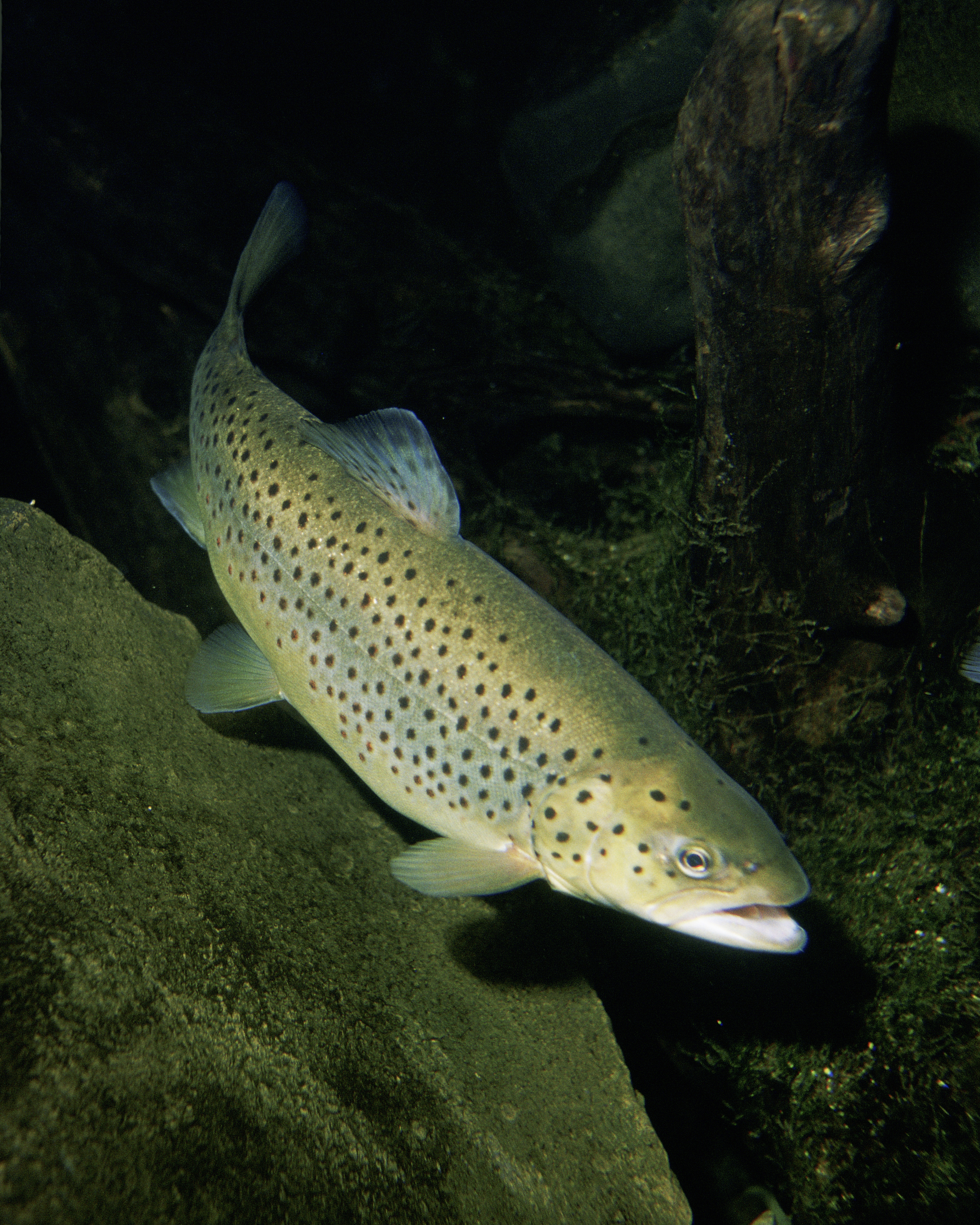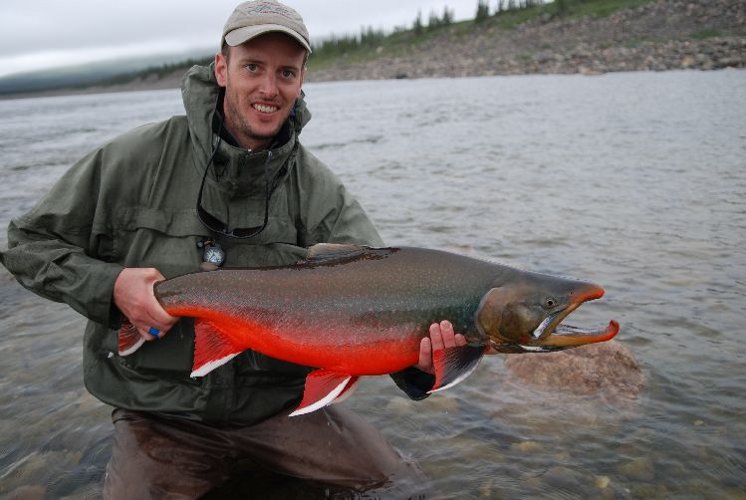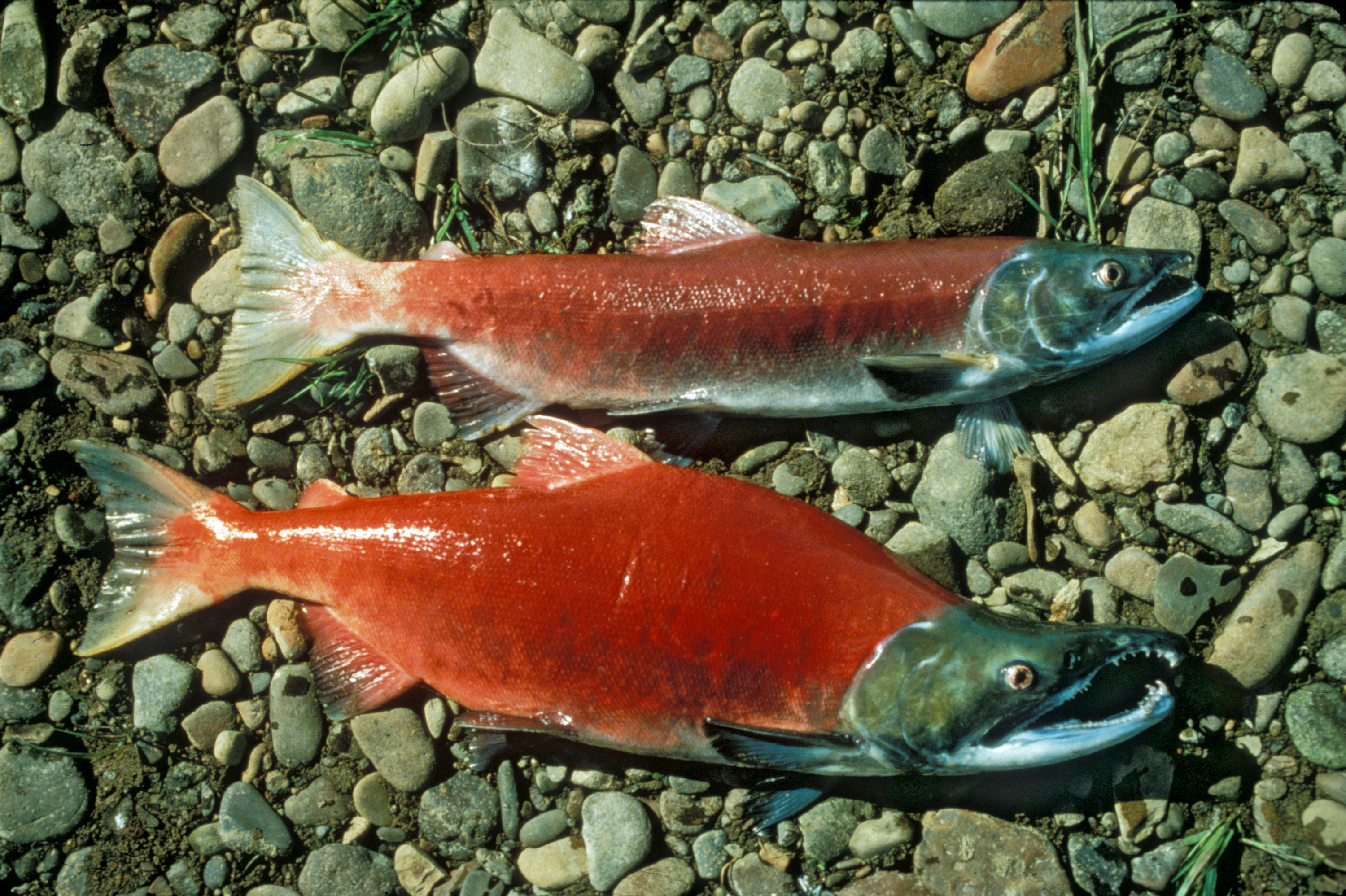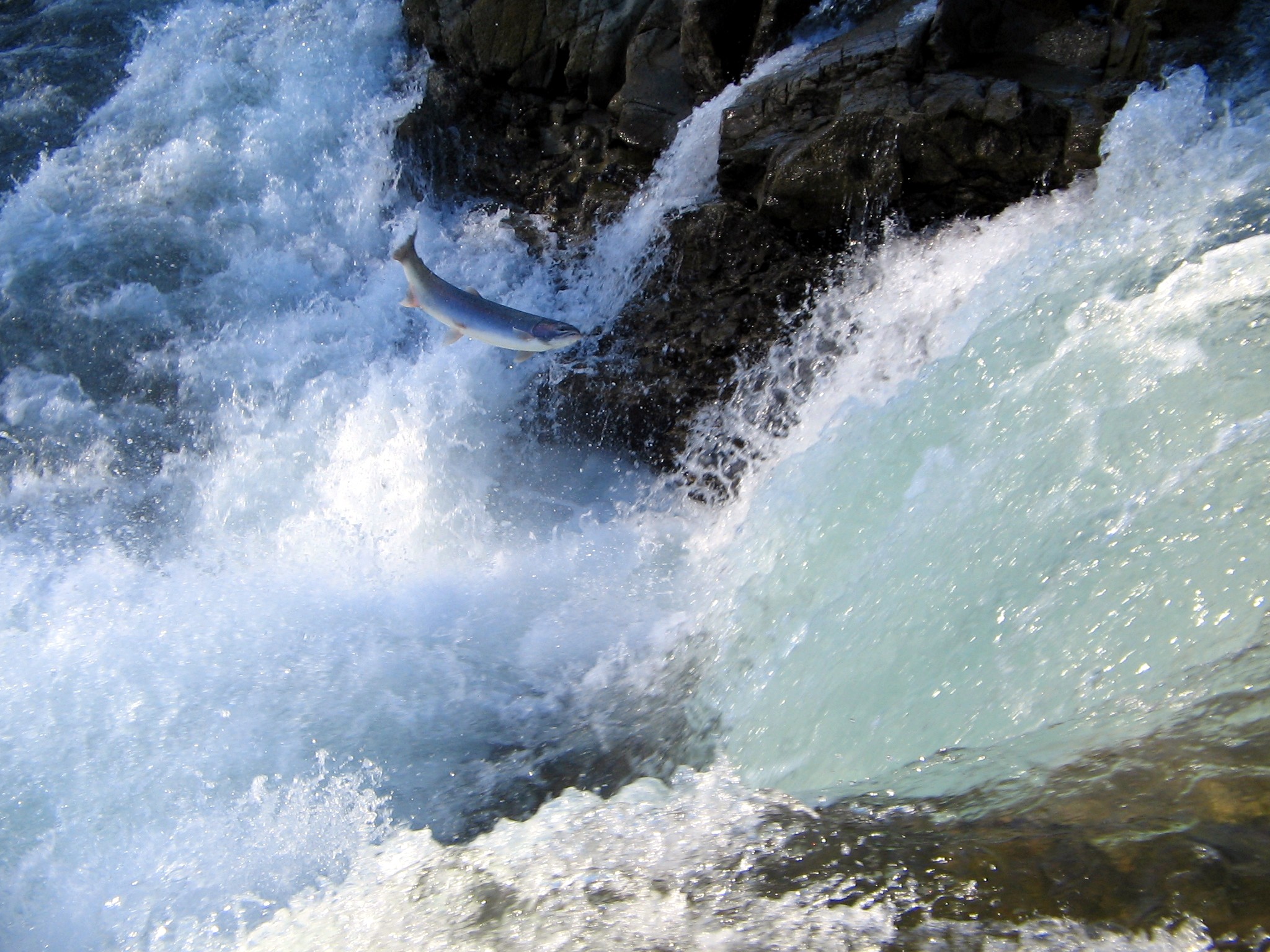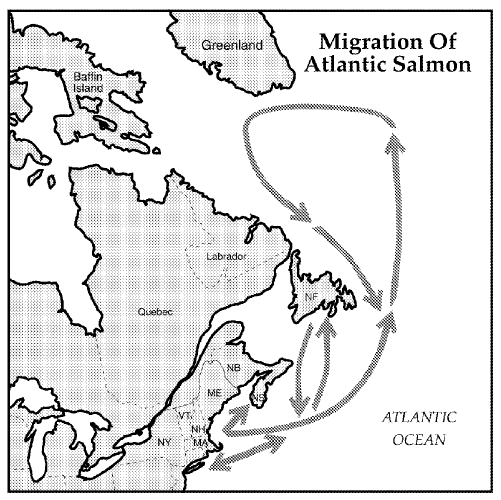|
Oncorhynchus
''Oncorhynchus'', from Ancient Greek ὄγκος (''ónkos''), meaning "bend", and ῥύγχος (''rhúnkhos''), meaning "snout", is a genus of ray-finned fish in the subfamily Salmoninae of the family (biology), family Salmonidae, native to coldwater tributaries of the North Pacific basin. The genus contains twelve extant taxon, extant species, namely six species of Pacific salmon and six species of Pacific trout, all of which are fish migration, migratory (either anadromous or potamodromous) mid-trophic level, level predatory fish that display natal homing and semelparity. The name of the genus is derived from Ancient Greek ὄγκος (''ónkos''), meaning "bend", and ῥύγχος (''rhúnkhos''), meaning "snout", in reference to the hooked secondary sexual characteristic — known as the kype — that the males develop on the lower jaw tip during mating season. Range Salmon and trout within ''Oncorhynchus'' are native to the tributaries of the North Pacific Ocean, with th ... [...More Info...] [...Related Items...] OR: [Wikipedia] [Google] [Baidu] |
Salmon
Salmon (; : salmon) are any of several list of commercially important fish species, commercially important species of euryhaline ray-finned fish from the genera ''Salmo'' and ''Oncorhynchus'' of the family (biology), family Salmonidae, native to tributary, tributaries of the North Atlantic (''Salmo'') and North Pacific (''Oncorhynchus'') basins. ''Salmon'' is a colloquial or common name used for fish in this group, but is not a scientific name. Other closely related fish in the same family include trout, Salvelinus, char, Thymallus, grayling, Freshwater whitefish, whitefish, lenok and Hucho, taimen, all coldwater fish of the subarctic and cooler temperate regions with some sporadic endorheic populations in Central Asia. Salmon are typically fish migration, anadromous: they hatch in the shallow gravel stream bed, beds of freshwater headstreams and spend their juvenile fish, juvenile years in rivers, lakes and freshwater wetlands, migrate to the ocean as adults and live like sea ... [...More Info...] [...Related Items...] OR: [Wikipedia] [Google] [Baidu] |
Sockeye Salmon
The sockeye salmon (''Oncorhynchus nerka''), also called red salmon, kokanee salmon, blueback salmon, or simply sockeye, is an anadromous species of salmon found in the Northern Pacific Ocean and rivers discharging into it. This species is a Pacific salmon that is primarily red in hue during spawning. They can grow up to in length and weigh . Juveniles remain in freshwater until they are ready to migrate to the ocean, over distances of up to . Their diet consists primarily of zooplankton. Sockeye salmon are semelparous, dying after they spawn. Some populations, referred to as kokanee, do not migrate to the ocean and live their entire lives in fresh water. Classification and name origin The sockeye salmon is the third-most common Pacific salmon species, after pink and chum salmon. ''Oncorhynchus'' comes from Ancient Greek ὄγκος (''ónkos''), meaning "bend", and ῥύγχος (''rhúnkhos''), meaning "snout". The specific name ''nerka'' is the Russian name for ... [...More Info...] [...Related Items...] OR: [Wikipedia] [Google] [Baidu] |
Trout
Trout (: trout) is a generic common name for numerous species of carnivorous freshwater ray-finned fishes belonging to the genera '' Oncorhynchus'', ''Salmo'' and ''Salvelinus'', all of which are members of the subfamily Salmoninae in the family Salmonidae. The word ''trout'' is also used for some similar-shaped but non-salmonid fish, such as the spotted seatrout/speckled trout (''Cynoscion nebulosus'', which is actually a croaker). Trout are closely related to salmon and have similar migratory life cycles. Most trout are strictly potamodromous, spending their entire lives exclusively in freshwater lakes, rivers and wetlands and migrating upstream to spawn in the shallow gravel beds of smaller headwater creeks. The hatched fry and juvenile trout, known as ''alevin'' and ''parr'', will stay upstream growing for years before migrating down to larger waterbodies as maturing adults. There are some anadromous species of trout, such as the steelhead (a coastal subs ... [...More Info...] [...Related Items...] OR: [Wikipedia] [Google] [Baidu] |
Oncorhynchus Gorbuscha
Pink salmon or humpback salmon (''Oncorhynchus gorbuscha'') is a species of euryhaline ray-finned fish in the family Salmonidae. It is the type species of the genus ''Oncorhynchus'' (Pacific salmon), and is the smallest and most abundant of the seven officially recognized species of salmon. The species' scientific name is based on the Russian common name for this species ''gorbúša'' (горбуша), which literally means ''humpie''. Description In the ocean, pink salmon are bright silver fish. After returning to their spawning streams, their coloring changes to pale grey on the back with yellowish-white belly (although some turn an overall dull green color). As with all salmon, in addition to the dorsal fin, they also have an adipose fin. The fish is characterized by a white mouth with black gums, no teeth on the tongue, large oval-shaped black spots on the back, a v-shaped tail, and an anal fin with 13–17 soft rays. During their spawning migration, males develop a pronou ... [...More Info...] [...Related Items...] OR: [Wikipedia] [Google] [Baidu] |
Salmoninae
Salmonidae (, ) is a family of ray-finned fish, the only extant member of the suborder Salmonoidei, consisting of 11 extant genera and over 200 species collectively known as "salmonids" or "salmonoids". The family includes salmon (both Atlantic and Pacific species), trout (both ocean-going and landlocked), char, graylings, freshwater whitefishes, taimens and lenoks, all coldwater mid-level predatory fish that inhabit the subarctic and cool temperate waters of the Northern Hemisphere. The Atlantic salmon (''Salmo salar''), whose Latin name became that of its genus ''Salmo'', is also the eponym of the family and order names. Salmonids have a relatively primitive appearance among teleost fish, with the pelvic fins being placed far back, and an adipose fin towards the rear of the back. They have slender bodies with rounded scales and forked tail fins, and their mouths contain a single row of sharp teeth. Although the smallest salmonid species is just long for adults, most salm ... [...More Info...] [...Related Items...] OR: [Wikipedia] [Google] [Baidu] |
Salmonidae
Salmonidae (, ) is a family (biology), family of ray-finned fish, the only extant member of the suborder Salmonoidei, consisting of 11 extant genera and over 200 species collectively known as "salmonids" or "salmonoids". The family includes salmon (both Atlantic and Pacific species), trout (both ocean-going and landlocked), Salvelinus, char, Thymallus, graylings, freshwater whitefishes, taimens and lenoks, all coldwater fish, coldwater mid-trophic level, level predatory fish that inhabit the subarctic and cool temperate waters of the Northern Hemisphere. The Atlantic salmon (''Salmo salar''), whose Latin name became that of its genus ''Salmo'', is also the eponym of the family and order names. Salmonids have a relatively primitive appearance among teleost fish, with the pelvic fins being placed far back, and an adipose fin towards the rear of the back. They have slender bodies with rounded fish scale, scales and forked caudal fin, tail fins, and their fish jaw, mouths contain a si ... [...More Info...] [...Related Items...] OR: [Wikipedia] [Google] [Baidu] |
Kype
A kype is a hook-like secondary sex characteristic which develops at the distal tip of the lower jaw in some male salmonids prior to the spawning season. The structure usually develops in the weeks prior to, and during, migration to the spawning grounds. In addition to the development of the kype, a large depression forms in the two halves of the premaxilla in the upper jaw, allowing the kype to fit into the premaxilla when the mouth is closed. The kype functions as a secondary sexual characteristic and influences the formation of dominance hierarchies at the spawning grounds. The size of the kype is believed to determine male spawning frequency. Description The kype grows rapidly from bony needles proliferating from the tip of the dentary (the anterior and largest of the bones making up the lower jaw). The needles form a mesh, but do not interfere with the connective tissues used by bone marrow. At the snout, the needles strengthen into Sharpey's fibres. The speed at which the k ... [...More Info...] [...Related Items...] OR: [Wikipedia] [Google] [Baidu] |
Semelparity
Semelparity and iteroparity are two contrasting reproductive strategies available to living organisms. A species is considered ''semelparous'' if it is characterized by a single reproduction, reproductive episode before death, and ''iteroparous'' if it is characterized by multiple reproductive cycle, reproductive cycles over the course of its lifetime. ''Iteroparity'' can be further divided into continuous iteroparity (primates, including humans and chimpanzees) and seasonal iteroparity (birds, dogs, etc.) Some Botany, botanists use the parallel terms monocarpy and polycarpy. (See also plietesials.) In truly ''semelparous'' species, death after reproduction is part of an overall strategy that includes putting all available resources into maximizing reproduction, at the expense of future life (see #Trade-offs, § Trade-offs). In any ''iteroparous'' population there will be some individuals who happen to die after their first and before any second reproductive episode, but unless ... [...More Info...] [...Related Items...] OR: [Wikipedia] [Google] [Baidu] |
Anadromous
Fish migration is mass relocation by fish from one area or body of water to another. Many types of fish migrate on a regular basis, on time scales ranging from daily to annually or longer, and over distances ranging from a few metres to thousands of kilometres. Such migrations are usually done for better feeding or to reproduce, but in other cases the reasons are unclear. Fish migrations involve movements of schools of fish on a scale and duration larger than those arising during normal daily activities. Some particular types of migration are ''anadromous'', in which adult fish live in the sea and migrate into fresh water to spawn; and ''catadromous'', in which adult fish live in fresh water and migrate into salt water to spawn. Marine forage fish often make large migrations between their spawning, feeding and nursery grounds. Their movements are associated with ocean currents and with the availability of food in different areas at different times of the year. The migratory ... [...More Info...] [...Related Items...] OR: [Wikipedia] [Google] [Baidu] |
Potamodromous
Fish migration is animal migration, mass relocation by fish from one area or body of water to another. Many types of fish migrate on a regular basis, on time scales ranging from daily to annually or longer, and over distances ranging from a few metres to thousands of kilometres. Such migrations are usually done for better feeding or to reproduce, but in other cases the reasons are unclear. Fish migrations involve movements of school of fish, schools of fish on a scale and duration larger than those arising during normal daily activities. Some particular types of migration are ''anadromous'', in which adult fish live in the sea and migrate into fresh water to spawn (biology), spawn; and ''catadromous'', in which adult fish live in fresh water and migrate into salt water to spawn. Marine forage fish often make large migrations between their spawning, feeding and nursery grounds. Their movements are associated with ocean currents and with the availability of food in different area ... [...More Info...] [...Related Items...] OR: [Wikipedia] [Google] [Baidu] |
Johann Julius Walbaum
Johann Julius Walbaum (30 June 1724 – 21 August 1799) was a German physician, natural history, naturalist and fauna taxonomist. Works Walbaum was from Greifswald. As an ichthyologist, he was the first to describe many previously unknown fish species from remote parts of the globe, such as the Barracuda, Great Barracuda (''Sphyraena barracuda''), the Chum salmon (''Oncorhynchus keta'') from the Kamchatka River in Siberia, and the curimatá-pacú (''Prochilodus marggravii'') from the São Francisco River in Brazil. Walbaum was one of the first to observe gloves as a preventative against infection in medical surgery. As early as 1767, he used gloves made from sheep intestines for vaginal exams. Legacy The Natural History Museum in Lübeck, opened in 1893, was based on Walbaum's extensive scientific collection. The museum's collection was, however, destroyed during the Bombing of Lübeck in World War II, Bombing of Lübeck. See also * References 18th-century German ... [...More Info...] [...Related Items...] OR: [Wikipedia] [Google] [Baidu] |



